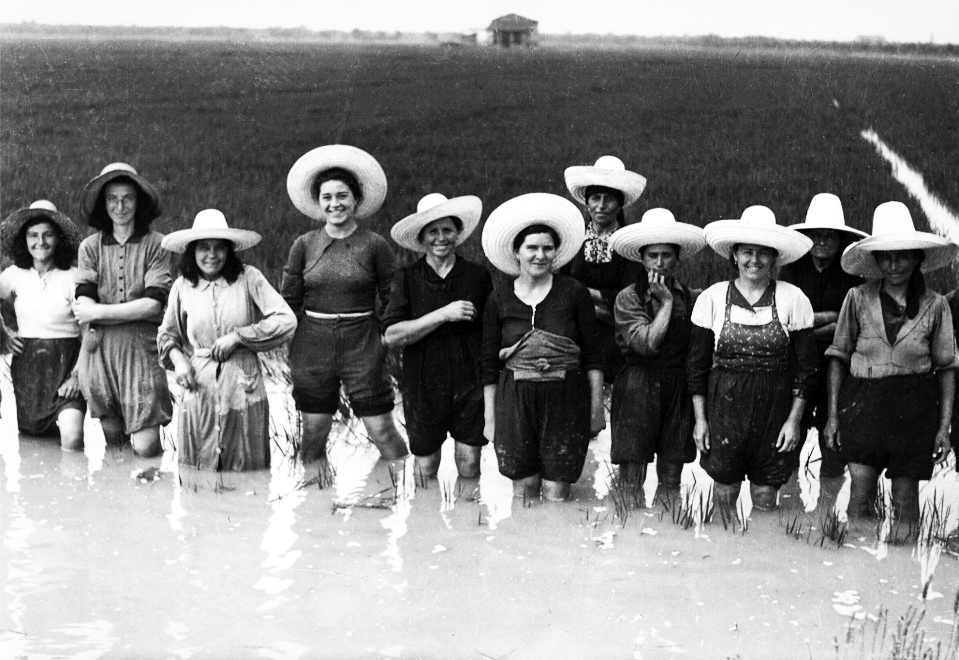The Forgotten Women of Italy’s Rice Fields
It is difficult to say when rice was first grown in Italy, but it was probably during the late Middle Ages. The earliest documentation of rice cultivation dates to 1475, where its cultivation in a Lombard plain was promoted by Galeazzo Maria Sforza, the Duke of Milan.
The most spectacular period of progress of the Italian rice cultivation began in the middle of 19th century, when a series of large irrigation systems were constructed in northern Italy. Fed by the rivers Po, Dora Baltea, Sesia and Ticino, as well as Lake Maggiore, an area of approximately 988,500 acres was cultivated for the production of rice. Italy currently has over 500,000 acres devoted to rice.
Rarely remembered today, the women who once toiled in Italy’s rice fields tells a remarkable story of activism. In an era before the dawn of pesticides and mechanization, an all-female workforce was employed to disinfect and harvest Italy’s rice crops. These Italian rice weeders may be a thing of the past, but they have a remarkable political legacy.
Italy was and remains Europe’s largest rice producer. The rice weeders, known in Italian as mondine, could be found knee-deep in the flooded fields from May until July, across Italy’s “rice belt” – spanning the northern regions of Piedmont, Emilia Romagna, Lombardy and the Veneto.
Although not permitted to talk during working hours, the flooded rice fields were often filled with the sound of weeders’ protest songs, who developed a repertoire of call-and-response songs, often lamenting miserable working conditions or exploitative employers.
In 1953, one Italian senator went as far as to say that the labor of rice weeders deserved its own circle of hell in Dante’s inferno. In the early part of the 20th century, one of the concessions won by the women was for an eight-hour work day. Under the beating summer sun, the rice weeders were constantly tormented by malaria-carrying mosquitoes. Malnourishment was commonplace and as a group, the women suffered much higher miscarriage rates than other women workers.
When the actress Silvana Mangano was shown how to imitate the rice weeders’ labor for her role in the film “Riso Amaro” (Bitter Rice) in 1949, she reportedly said: “Like this, for eight hours? I wouldn’t do this work even for a million dollars a day!”
The exploitative conditions led to political activism, which thrived in the fields, along with the rice. Beginning in the early part of the 20th century, many of the mondine joined left-wing organizations such as the Italian communist and socialist parties, seeking to throw off the yoke of oppression. Others joined the Unione donne italiane (the Italian Women’s Union) and working class institutions such as the Case del Popolo (People’s Houses) and cooperatives. Under Italian fascism, between 1922 and 1943, left-wing groups were forced underground, but the rice weeders won important concessions from the fascist government through strikes and protests.
During the Nazi occupation of Italy, many mondine deserted the rice fields and in 1944 refused to work for their oppressors. Some did not return to work until the fall of fascism. But these women were also active in Italy’s liberation from the Nazis. Many were part of the Italian Resistance, hiding partisans in their homes or acting as couriers between battalions. Unfortunately, the mondine’s participation in the liberation of Italy from the Nazis and fascists has often gone unrecognized. However, in present-day Italy, the mondine have gained a cult following for their songs and their dress. Choirs now perform their songs at festivals in Italy and abroad.
“Bitter Rice” was written and directed by Giuseppe De Santis and produced by Dino De Laurentiis. The film was a commercial success in Europe and the United States. Although Bitter Rice did not win any awards, it was nominated for the 1950 Academy Award for Best Story and entered into the 1949 Cannes Film Festival. The film’s success catapulted the weeders into the public consciousness, not the least of which due to their manner of dress. Traditionally, the weeders had worn long skirts in the fields, but in the film, Mangano wore shorts and ripped stockings. The weeders subsequently adopted this style and it became their most remembered and reproduced characteristic.
During subsequent decades, mechanization made the mondine’s role less and less important until the role of the women in the rice fields became entirely unnecessary. In 1939, each two and a half acres required an average of 1,028 hours of work. Due to mechanization, today it requires less than 50 hours.
Although their role may be long gone, the rice weeders story of commitment and resolve to fight oppression is a story of strength that should be remembered. The style of dress worn by Silvana Mangano in “Bitter Rice” was resurrected in 2014 by women in Milan, who protested the import of rice from Asia, demonstrating that the spirit of righteousness embodied by the mondine is still alive in Italy.





